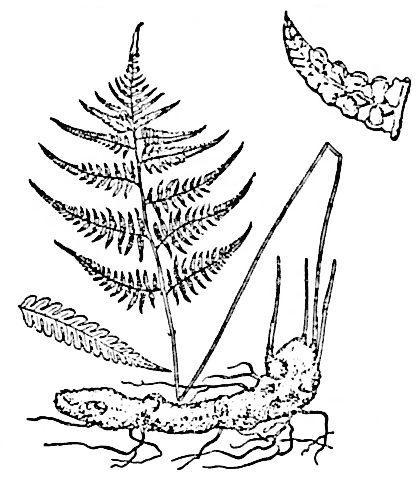This is a species of tree fern native to parts of China and to the western part of the Malay Peninsula.
FUNCTIONS
GROUP: Tonic- Tonify Yang
1. Tone up Liver and Kidney.[1] Strengthen tendons and bone.[2] Strengthen the back and knees.[1]
2. Expel Wind and Dampness.[2] Eliminates rheumatism.[1]
INDICATIONS
1. Sore loins and spin, weakness of lower limbs, pain in muscles and joints.[1,2] Numbness of hands and feet.[1] Rheumatoid arthritis.[1]
2. Traumatic bleeding.[1]
3. White vaginal discharge.[2]
References
PREPARATIONS: Concoction - Roots and stems 9-15 g for each dose. Downy hairs are used for application on wounds to stop bleeding.[1] Dried rhizome 4-9 g.[2]
 HABITAT:
Found growing on hillsides, gullies and in forests where it is shady and damp.
HABITAT:
Found growing on hillsides, gullies and in forests where it is shady and damp.DESCRIPTION: Perennial evergreen herb. Rhizome; thick and fleshy, densely covered by golden-yellow scales. Leaves; clustered, long-petioles, brown, bases deltate, 3 times pinnately compound, leaflets alternate, lanceolate, apexes acute, bases obtuse, margins finely serrated. Sori; attached to both sides of central rib on dorsal side of leaf.
References
Inner Path can not take any responsibility for any adverse effects from the use of plants. Always seek advice from a professional before using a plant medicinally.
Research
Anti-osteoporosis activity of Cibotium barometz extract on ovariectomy-induced bone loss in rats.
Zhao X, Wu ZX, Zhang Y, Yan YB, He Q, Cao PC, Lei W.
Abstract
ETHNOPHARMACOLOGICAL RELEVANCE:
Recent research has confirmed that Cibotium barometz could inhibits osteoclast formation with no affect on BMM cell viability. However, the influence of Cibotium barometz on osteoporosis in animals is relatively unknown. The purpose of this study is to systemically investigate the effects of Cibotium barometz extract (CBE) on ovariectomy-induced osteoporosis in rats.
MATERIALS AND METHODS:
A total of Seventy-two 3-month-old female Sprague-Dawley rats were used and randomly divided into sham-operated group and five ovariectomized (OVX) groups: OVX with vehicle; OVX with 17β-estradiol (E2, 25 μg/kg/day); OVX with CBE of graded doses (100, 300, or 500 mg/kg/day). Daily oral administration of E2 or CBE began 4 weeks after the surgery and lasted for 16 weeks. Bone mass, bone turnover and strength were analyzed by DEXA, biochemical markers and three-point bending test. The trabecular bone microarchitecture was evaluated by MicroCT.
RESULTS:
CBE prevented total BMD decrease in the femur induced by OVX, which was accompanied by a significant decrease in skeletal remodeling, as was evidenced by the decreased levels of the bone turnover markers, such as osteocalcin (OC), alkaline phosphatese (ALP), deoxypyridinoline (DPD), and urinary Ca and P excretions. The treatment could also enhance the bone strength and prevent the deterioration of trabecular microarchitecture.
CONCLUSIONS:
The present study indicated that Cibotium barometz extract might be a potential alternative medicine for the prevention and treatment of postmenopausal osteoporosis.
J Ethnopharmacol. 2011 Oct 11;137(3):1083-8. doi: 10.1016/j.jep.2011.07.017. Epub 2011 Jul 18. ncbi.nlm.nih.gov
Adjunctive treatment of axial undifferentiated spondyloarthritis by
Qiangji Recipe: a clinical study.
[Article in Chinese]
He MY, Fan FY.
Abstract
OBJECTIVE:
To evaluate the clinical efficacy and safety of Qiangji Recipe (QR) in ad-
junctive treatment of axial undifferentiated spondyloarthritis (axuSpA) through
a four-week open study.
METHODS:
Fifty-four axuSpA patients of Shen-deficiency Du-channel cold syndrome (SDDCS)
in line with inclusive criteria were recruited and assigned to the treatment
group and the control group according to random digit table, 27 in each group.
Patients in the control group took Celecoxib Capsule (0.2 g each time, twice
per day). Patients in the treatment group additionally took QR (consisting
of Herba Epimedii 15 g, antler glue 15 g, Cibotium Barometz 15 g, eucommia
bark 20 g, dipsacus asper 10 g, two toothed achyranthes root 15 g, drynaria
15 g, Taxillus Chinensis 20 g, ground beetle 10 g, scorpion 5 g, wild celery
10 g, notopterygium incisium 10 g, cow-fat seed 10 g, white mustard seed 6
g, and licorice root 6 g, one dose per day, twice daily). The therapeutic
course for all was 4 weeks. The Bath Ankylosing Spondylitis Disease Activity
Index (BASDAI), the Bath Ankylosing Spondylitis Functional Index (BASFI),
the Bath AS Metrology Index (BASMI), total body pain and spinal pain, patient
and physician global assessment on a four-point scale, the Ankylosing Spondylitis
Quality of Life (ASQoL), erythrocyte sedimentation rate (ESR) and C-reactive
protein (CRP) were measured before and after 4 weeks of treatment. The primary
end point in this study was the proportion of patients with a 20%improvement
response accord- ing to the ASAS International Working Group Criteria (ASAS
20 responders) at week 4.
RESULTS:
Totally 50 patients completed this trial, 26 in the treatment group and 24
in the control group. Improvement of BASDAI, BASFI, BASMI, ASQoL, ESR, and
CRP was shown in both groups after treatment. Better effect was shown in the
treatment group in all indices except ESR and BASMI after treatment (P <
0.05, P < 0.01). Twenty cases (accounting for 76.92%) in the treatment
group achieved ASAS 20 response at week 4, while 12 cases (accounting for
50.00%) in the control group achieved ASAS 20 response at week 4 (P < 0.05).
No obvious adverse reaction occurred in the two groups.
CONCLUSION:
QR combined Celecoxib Capsule showed better effect in treating axuSpA patients
than using Celecoxib Capsule alone.
Zhongguo Zhong Xi Yi Jie He Za Zhi. 2015 Jan;35(1):37-40. ncbi.nlm.nih.gov